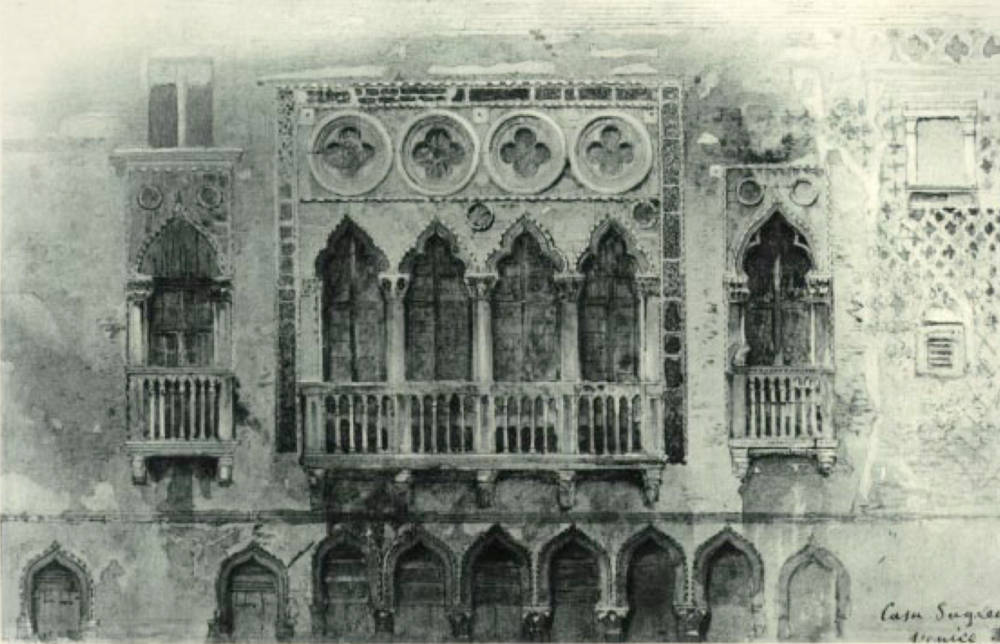
Click on image to enlarge it. Ruskin’s two drawings of the palazzo's windows suggest that Sagredo is the building a corner of which we see at right.

Windows of the Third and Fourth Orders: The Casa Sagredo. John Ruskin. “From the collection of George Thomson, Esq., Huddersfield.” Facing 10.299. Compare the single window an illustration of which Ruskin illustrated facing 10/288/
In The Stones of Venice John Ruskin describes this palazzo as “much defaced, but full of interest. Its sea story is restored; its first floor has a most interesting arcade of the early thirteenth century third order windows; its upper windows are the finest fourth and fifth orders of early fourteenth century; the group of fourth orders in the centre being brought into some resemblance to the late Gothic traceries by the subsequent introduction of the quatrefoils above them.” (11.428)
In the third volume’s chapter entitled “Early Renaissance,” Ruskin employs the Sangredo as an example of “the union of one color with another by reciprocal interference,” which takes to be a matter of major importance both for art and life:
there is one magnificent attribute of the coloring of the late twelfth, the whole thirteenth, and the early fourteenth century, which I do not find definitely in any previous work, nor afterwards in general art, though constantly, and necessarily, in that of great colorists, namely, the union of one color with another by reciprocal interference: that is to say, if a mass of red is to be set beside a mass of blue, a piece of the red will be carried into the blue, and a piece of the blue carried into the red; sometimes in nearly equal portions, as in a shield divided into four quarters, of which the uppermost on one side will be of the same color as the lowermost on the 19 other; sometimes in smaller fragments, but, in the periods above named, always definitely and grandly, though in a thousand various ways. And I call it a magnificent principle, for it is an eternal and universal one, not in art only,4 but in human life. It is the great principle of Brotherhood, not by equality, nor by likeness, but by giving and receiving; the souls that are unlike, and the nations that are unlike, and the natures that are unlike, being bound into one noble whole by each receiving something from, and of, the others’ gifts and the others’ glory. I have not space to follow out this thought,—it is of infinite extent and application,—but I note it for the reader’s pursuit, because I have long believed, and the whole second volume of “Modern Painters” was written to prove, that in whatever has been made by the Deity externally delightful to the human sense of beauty, there is some type of God’s nature or of God’s laws; nor are any of His laws, in one sense, greater than the appointment that the most lovely and perfect unity shall be obtained by the taking of one nature into another. I trespass upon too high ground; and yet I cannot fully show the reader the extent of this law, but by leading him thus far. And it is just because it is so vast and so awful a law, that it has rule over the smallest things; and there is not a vein of color on the lightest leaf which the spring winds are at this moment unfolding in the fields around 20 us, but it is an illustration of an ordainment to which the earth and its creatures owe their continuance, and their Redemption. [11.23-24]
After defending the use in Gothic architecture of stucco, not as imitating stone, but as a “ground for receiving colour from the human hand, —color which, if well laid on, might render the brick wall more precious than if it had been built of emeralds” (11.26), Ruskin turns to “the chromatic decoration of the Gothic palaces of Venice” (11.27):
The walls were generally covered with chequers of very warm color, a russet inclining to scarlet, more or less relieved with white, black, and grey; as still seen in the only example which, having been executed in marble, has been perfectly preserved, the front of the Ducal Palace. This, however, owing to the nature of its materials, was a peculiarly simple example; the ground is white, crossed with double bars of pale red, and in the centre of each chequer there is a cross, alternately black with a red centre and red with a black centre where the arms cross. In painted work the grounds would be, of course, as varied and complicated as those of manuscripts; but I only know of one example left, on the Casa Sagredo, where, on some fragments of stucco, a very early chequer background is traceable, composed of crimson quatrefoils interlaced, with cherubim stretching their wings filling the intervals. [11.27-28]
More of Ruskin's Venice
- St. Mark’s
- The Palazzo Ducale, Venice
- The Scuola de San Rocco
- On the Grand Canal
- Leaving the Grand Canal
- On the way to Venice from the mainland
- Venice: Details and Corners
Photographs 2020. [You may use these images without prior permission for any scholarly or educational purpose as long as you (1) credit the photographer and (2) link your document to this URL in a web document or cite the Victorian Web in a print one.]
Bibliography
Ruskin, John. The Works. Ed. E. T. Cook and Alexander Wedderburn. “The Library Edition.” 39 vols. London: George Allen, 1903-1912.
� �
Last Modified 21 March 2020